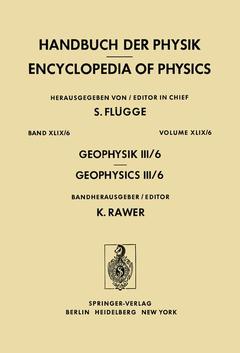Geophysik III, Softcover reprint of the original 1st ed. 1982 Geophysik / Geophysics Series
Langue : Anglais
Auteurs : Nikol'skij G.M., Rawer K., Stubbe P., Thomas L., Yonezawa T.
Coordonnateur : Rawer Karl

83 input to the ions is balanced by a cooling to atomic oxygen, the major neutral constituent, and measurements of the difference between ion and neutral tem perature permit the determination of atomic oxygen concentrations. Using this approach, ALCA YDE et al. 6 have shown from data taken above Saint Santin, France, that the atomic oxygen concentration at 200 km is slightly larger in winter than summer. () The molecular concentrations at heights near 200 km can also be derived from a determination of the ratio of the molecular-ion concentration to elec tron concentration, p (Cox and EVANS 7). It can be shown from the steady state form of the continuity equation for 0+ ions that (20.2) where Q(O+) represents the photoionization coefficient of oxygen atoms, and k and k19 represent the rate coefficients of reactions between 0+ ions and 1S molecular nitrogen Illld oxygen (reactions (12.18) and (12.19)). Then the ratio of atomic oxygen to weighted molecular sum is given by: (l-p)Ne [OJ (20.3) Q(O+) , [kMJ where Ne represents the electron concentration.
: A Summary Description of Aeronomy.- The Neutral and Ion Chemistry of the Upper Atmosphere.- A. Neutral and ionized atmospheric structure and composition.- B. Interactions of solar radiations with atmospheric gases.- C. Collision processes and chemical reactions.- D. Laboratory measurements of relevant rate coefficients.- E. Experimental methods for measurement of neutral and ion composition.- F. Aeronomical models of neutral composition.- G. Aeronomical models of ion composition.- I. Characteristics of ionospheric regions.- II. The ion chemistry of the D region.- III. The ion chemistry of the E region.- IV. The ion chemistry of the F region.- H. The production of excited species and their roles in atmospheric and ionospheric processes.- General references.- Diffusion in the High Atmosphere.- I. Introduction and the general theory of diffusion.- II. Diffusive equilibrium, mixing, and turbulence in the high atmosphere.- III. Vertical distributions of molecular and atomic oxygen.- IV. Ambipolar diffusion including the formation of the F2-layer.- V. Vertical distributions of minor constituents in the high atmosphere.- General references.- Interaction of Neutral and Plasma Motions in the Ionosphere.- A. Introduction.- B. Fundamental equations.- I. Equation of motion for the neutral gas.- II. Auxiliary transport equations for wind calculations.- III. Applicability of the transport equations in the upper atmosphere.- C. Calculation of wind velocities.- I. Methods of calculating wind velocities.- II. Characteristics of calculated wind velocities.- D. Observed wind velocities.- E. Effects of winds on the ionosphere.- I. Direct effects.- II. Indirect effects.- F. Effects of plasma motions on the neutral wind.- G. Conclusion.- List of main symbols.- General references.- Extreme Ultraviolet Observational Data on the Solar Spectrum.- I. Spectral observations.- II XUV solar images.- III. Observation of x-ray solar radiation over wide spectral ranges.- IV. Identification and prediction of extreme ultraviolet lines.- V. Chemical composition of the solar atmosphere derived from EUV data.- General references.
Date de parution : 08-1982
Date de parution : 01-2012
Ouvrage de 386 p.
17x24.4 cm
Disponible chez l'éditeur (délai d'approvisionnement : 15 jours).
Prix indicatif 105,49 €
Ajouter au panierMots-clés :
© 2024 LAVOISIER S.A.S.



